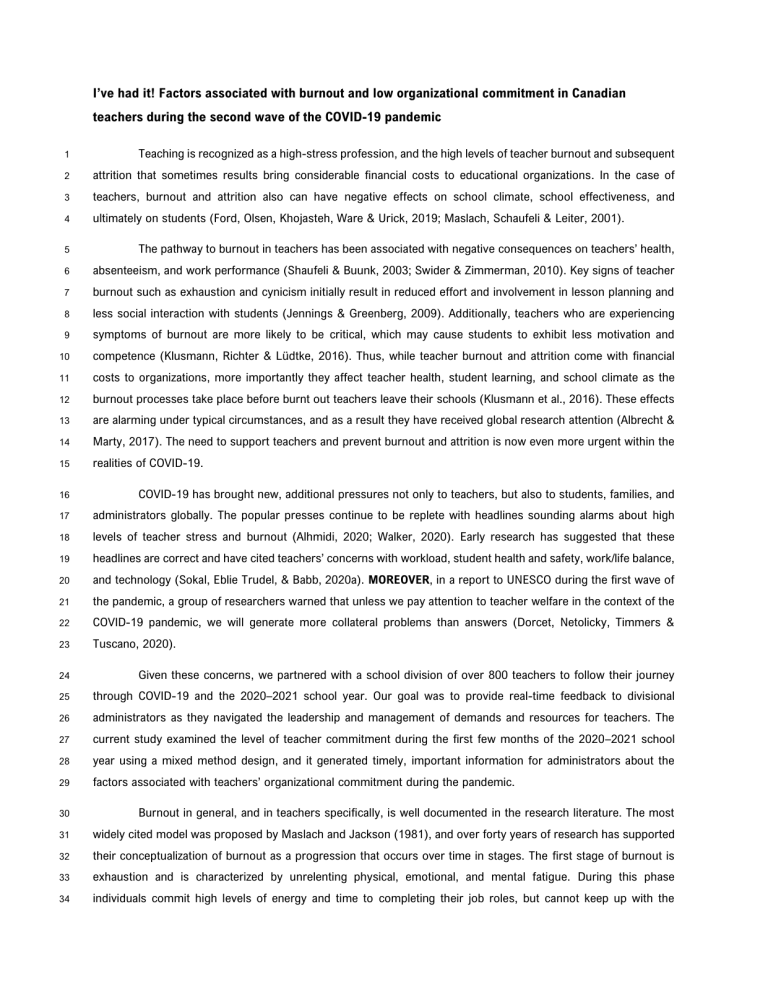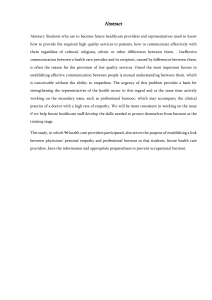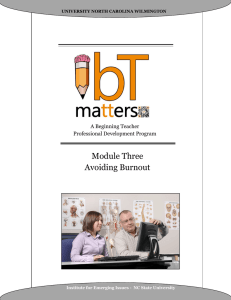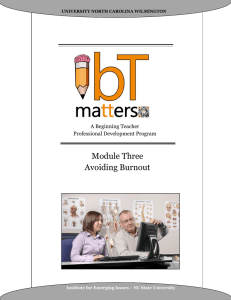
I’ve had it! Factors associated with burnout and low organizational commitment in Canadian teachers during the second wave of the COVID-19 pandemic 1 Teaching is recognized as a high-stress profession, and the high levels of teacher burnout and subsequent 2 attrition that sometimes results bring considerable financial costs to educational organizations. In the case of 3 teachers, burnout and attrition also can have negative effects on school climate, school effectiveness, and 4 ultimately on students (Ford, Olsen, Khojasteh, Ware & Urick, 2019; Maslach, Schaufeli & Leiter, 2001). 5 The pathway to burnout in teachers has been associated with negative consequences on teachers’ health, 6 absenteeism, and work performance (Shaufeli & Buunk, 2003; Swider & Zimmerman, 2010). Key signs of teacher 7 burnout such as exhaustion and cynicism initially result in reduced effort and involvement in lesson planning and 8 less social interaction with students (Jennings & Greenberg, 2009). Additionally, teachers who are experiencing 9 symptoms of burnout are more likely to be critical, which may cause students to exhibit less motivation and 10 competence (Klusmann, Richter & Lüdtke, 2016). Thus, while teacher burnout and attrition come with financial 11 costs to organizations, more importantly they affect teacher health, student learning, and school climate as the 12 burnout processes take place before burnt out teachers leave their schools (Klusmann et al., 2016). These effects 13 are alarming under typical circumstances, and as a result they have received global research attention (Albrecht & 14 Marty, 2017). The need to support teachers and prevent burnout and attrition is now even more urgent within the 15 realities of COVID-19. 16 COVID-19 has brought new, additional pressures not only to teachers, but also to students, families, and 17 administrators globally. The popular presses continue to be replete with headlines sounding alarms about high 18 levels of teacher stress and burnout (Alhmidi, 2020; Walker, 2020). Early research has suggested that these 19 headlines are correct and have cited teachers’ concerns with workload, student health and safety, work/life balance, 20 and technology (Sokal, Eblie Trudel, & Babb, 2020a). MOREOVER, in a report to UNESCO during the first wave of 21 the pandemic, a group of researchers warned that unless we pay attention to teacher welfare in the context of the 22 COVID-19 pandemic, we will generate more collateral problems than answers (Dorcet, Netolicky, Timmers & 23 Tuscano, 2020). 24 Given these concerns, we partnered with a school division of over 800 teachers to follow their journey 25 through COVID-19 and the 2020–2021 school year. Our goal was to provide real-time feedback to divisional 26 administrators as they navigated the leadership and management of demands and resources for teachers. The 27 current study examined the level of teacher commitment during the first few months of the 2020–2021 school 28 year using a mixed method design, and it generated timely, important information for administrators about the 29 factors associated with teachers’ organizational commitment during the pandemic. 30 Burnout in general, and in teachers specifically, is well documented in the research literature. The most 31 widely cited model was proposed by Maslach and Jackson (1981), and over forty years of research has supported 32 their conceptualization of burnout as a progression that occurs over time in stages. The first stage of burnout is 33 exhaustion and is characterized by unrelenting physical, emotional, and mental fatigue. During this phase 34 individuals commit high levels of energy and time to completing their job roles, but cannot keep up with the 35 demands. The second stage of burnout is cynicism, during which individuals begin to resent others and develop 36 a lack of empathy for them. Individuals at this stage of burnout sometimes feel that they have worked hard to 37 complete tasks but that others are not helping or are presenting roadblocks. Apathy for others is characteristic of 38 this stage. For teachers, the ‘others’ may include parents, administrators, or students themselves. The final stage 39 of burnout is loss of accomplishment. In this phase, teachers no longer feel they are capable of fostering student 40 learning and often leave the profession, defeated. 41 Many studies have supported the progression of teacher burnout as having a distinct order from 42 exhaustion to cynicism to loss of accomplishment, although some studies have shown the first two components 43 as a continuum, with the third component–loss of accomplishment–gradually and concurrently building as teachers 44 move from exhaustion to cynicism (Maslach et al., 2001). In either case, burnt out teachers are no longer effective 45 in their teaching roles and lack commitment to their schools and students, which often results in chronic 46 absenteeism, medical leaves of absence, and in some cases attrition (Schaufeli & Buunk, 2003; Swider & 47 Zimmerman, 2010). 48 Theorizing about teacher burnout has considered many contributing factors, and most are captured within 49 the job demands-resources model (Bakker & Demerouti, 2007). This model considers an individual’s subjective 50 appraisal of the demands of their job and its alignment with the internal and external resources available to meet 51 those demands. According to this model, high levels and durations of stress result from a mismatch of sufficient 52 resources to meet demands and have been associated with teacher burnout. 53 Although published research on teacher burnout during the COVID19 pandemic is scant, our very recent 54 national research study on burnout in 1327 Canadian teachers during the early stages of the pandemic in spring 55 2020 presented nascent findings which confirmed that teacher burnout during pandemic conditions is associated 56 with lower teacher efficacy, lower adaptability (as measured through attitudes toward change), and higher job 57 demands accompanied by lower resources (Sokal, Eblie Trudel, & Babb, 2020b). In terms of personal resources 58 such as efficacy for using effective strategies, managing behaviours, and engaging students (Tschannen-Moran & 59 Hoy, 2001), all three components of teaching efficacy were significantly and negatively correlated with exhaustion 60 and cynicism, and were significantly, positively correlated with accomplishment. Likewise, all three components 61 of attitudes toward change (thoughts, feelings, and actions) were significantly and negatively correlated with 62 exhaustion and cynicism, and significantly and positively correlated with accomplishment. Our subsequent national 63 longitudinal study reporting on changes in Canadian teacher burnout during remote teaching across two time 64 points from April to June 2020 showed significant increases in burnout scores over that time (Sokal, Eblie Trudel, 65 & Babb, 2020c). Considered alongside the warning from Dorcet et al. (2020) regarding the collateral damage that 66 will be caused by ignoring teacher welfare during a pandemic, these collective findings buttress calls to support 67 teachers to prevent their burnout and attrition. 68 Despite the copious pre-pandemic research related to teacher burnout and attrition, it is important to 69 remember that the majority of teachers under typical teaching conditions do not burn out. That is not to say that 70 they do not experience stress or high job demands, but rather they remain resilient and committed while teaching 71 under these same conditions. This observation begs the questions: why do teachers remain committed even when 72 it is challenging? Given that management of resources and demands often fall within the purview of administrators, 73 what can organizations do to address early signs of teacher burnout which may subsequently result in the intention 74 to leave the profession? The research literature on the organizational commitment of teachers has provided us 75 with some insights about these questions. 76 The relationship between teacher burnout, organizational commitment, and teacher attrition has received 77 substantial research attention. Meyer and Allen (1991) defined the organizational components of commitment as 78 an employee’s willingness to continue as part of an organization as a result of emotional attachment, feelings of 79 obligation, and acknowledgement of the high costs of leaving. In general, while research has confirmed a positive 80 correlation between burnout and attrition, it has also demonstrated a negative relationship between these two 81 variables and organizational commitment (Akdemir, 2019; Ford et al.,2019). 82 In addition to the personal resources previously discussed such as attitudes toward change and teacher 83 efficacy (Sokal, Eblie Trudel, & Babb, 2020b), a key influence cited in many research studies is the power of school 84 leaders to mitigate teacher burnout and attrition (Eyal & Roth, 2011; Podalsky, Kini, Bishop & Darling-Hammond, 85 2016; Richardson et al., 2008; Urick, 2016). Effective leaders balance the available resources with the job demands 86 of teachers and, in turn, alleviate burnout progression. Leadership actions such as cultivating a trusting and 87 empowering work environment through provision of resources (e.g., collaboration time and professional 88 development), as well as emotional and social support have been linked to positive teacher well-being (Van Maele 89 & Van Houtte, 2015), sustained organizational commitment (Conley & You, 2018), and decreased attrition (Hughes, 90 Matt & O’Reilly, 2015; Urick, 2016). 91 An important observation made by Ford et al. (2019) is that onsite administrators, usually principals, have 92 a strong influence on teachers both through their formal and informal interactions. The influence of principals 93 extends well beyond their control of tangible resources and demands that are often sited in burnout research about 94 teachers (Collie, Ganziera & Martin, 2018). Ford et al. (2019) provided copious evidence of effective actions by 95 principals that focus on psychological and relational aspects and have been shown to mitigate teacher burnout and 96 attrition –specifically during the earlier stages of exhaustion and cynicism (Collie et al., 2018). Effective actions 97 that principals can undertake are acknowledging teacher effort and sacrifice (Lambersky, 2016), giving teachers 98 the opportunity to voice their thoughts and to feel understood (Collie et al., 2018), and conveying concern in order 99 to gain trust and foster positive relationships (Adams & Olsen, 2017). MOREOVER, Ford et al. (2019) delineated 100 three dimensions of leadership support for teachers including (1) actions toward groups of teachers intended to 101 give teachers a voice in collective decision-making and improve school climate and social conditions 102 (organizational); (2) actions toward individual teachers intended to enhance personal and professional relationships 103 between administrators and teachers (interpersonal); and (3) the perceptions of these efforts by individual teachers 104 (intrapersonal). They suggested that attention by principals to all three aspects together is necessary to mitigate 105 burnout and attrition. MOREOVER, Collie et al. (2018) suggested that a focus by principals on promoting autonomy 106 in teachers was imperative to equipping them to adapt to novel circumstances and uncertainty (a context amplified 107 by the COVID-19 pandemic). Importantly, Ford et al. (2019) found that different aspects of school leadership 108 actions predicted different pathways of attrition, resulting in some teachers’ having intentions to leave a particular 109 school while others intended to leave the profession altogether. Ford et al. (2019) therefore cautioned that research 110 should examine the effects of leadership actions on teacher burnout and attrition as they relate to onsite 111 administrators of specific settings, as few studies have made this important differentiation between on-site and 112 divisional leadership effects on burnout. 113 While the current research and theorizing about burnout, resources, demands, and leadership has 114 provided a roadmap to understanding the relationship between teacher burnout and organizational commitment 115 under typical circumstances, these findings have not been tested under pandemic conditions. Given not only the 116 lacuna in the research literature but also the practical value of this as-yet unknown information, we designed the 117 current study to contribute to supporting teachers and schools in this new context. By Laura Sokal, Lesley Eblie Trudel, Jeff Babb published in the International Journal of Educational Research Open Answer questions 1 – 10 based on the text above. 1. Among the alternatives listed below, which one is not a consequence of teacher burnout? A. School effectiveness B. Fnancial costs C. School climate D. Student well-being E. All the above are consequences 2. All the signs below are indications of teacher burnout except? A. Cynicism B. Criticism C. Exhaustion D. Diminished professional efficacy 3. The word “MOREOVER” in lines 20, 99 and 105 can be replaced by all the word below except A. Besides B. Furthermore C. In addition D. Nevertheless E. Also 4. The role of leadership has been cited as important to alleviate burnout progression, this has been done through the options listed below. According to the text, which actions are true according to the text: i. emotional and social support ii. control available resources with the job demands and iii. Creation of a taskforce to analyze burnout and attrition. A. II and III B. All are true C. I and II D. I and III E. None of the above 5. According to a study carried out during pandemic conditions, teacher burnout related to the following except: A. Increased job demands B. Lower teacher efficacy C. Increased evasion D. Reduced resources E. Lower adaptability 6. Listed below are effective actions that leaders can undertake to ease teacher burnout and attrition, EXCEPT one A. Acknowledging teacher effort and sacrifice B. Giving teachers the opportunity to voice their thoughts and to feel understood C. Encourage relationships with colleagues and supervisors are equally D. Conveying concern to gain trust and foster positive relationships E. Promoting autonomy in teachers For questions 7 – 10, answer TRUE or FALSE 7. Research has confirmed a negative correlation between burnout and attrition, and a positive relationship between these two and organizational commitment 8. The motivation and competence of students is related to teachers who are experiencing symptoms of burnout 9. Teachers are more concerned with technology, workload, and student health and less in their work/life balance


